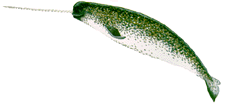This 'horn' is located in the Liverpool Museum in England. The horn is believed to have been made from the tusk of a narwhal. It measures 110cm long with a diameter of 5.2cm, tapering to 2.5cm.



- The true horn, when thrown into water, sends up little bubbles. The water seems to boil, though cold, and one can hear the boiling.
- The true horn gives out a sweet odor when burned.
- Poisonous plants and animals, when brought near the true horn, burst and die.
- The true horn sweats in the presence of poison.
- The true horn is always striated, is extremely hard, very heavy, the color of boxwood, and able to save the life of a pigeon poisoned with arsenic.
- Enclose a spider in a circle drawn on the floor with an alicorn. If the horn is true the spider will not be able to cross outside of the circle and will starve to death inside it.
- Place the horn in a vessel and with it three or four live and large scorpions, keeping the vessel covered. If four hours later the scorpions are dead, or almost lifeless, the alicorn is a true one.

Sea Unicorn and narwhal from Pierre Pomet's text on pharmacy, Histoire generale des drogues.


The narwhal (monodon monoceros) is one of the rarest whales known that lives in the Arctic. The male of this species has a single left tusk that is a modified upper incisor. The tusk is spirally twisted, usually in a counter-clockwise direction. In a mature specimen the tusk can be from two to seven meters long. The mammal is believed by many to have been the source of the legendary unicorn. The narwhal is not an endangered species, niether is it hunted commercially. It is hunted by the Inuit of Greenland and Canadaon on a quota system.